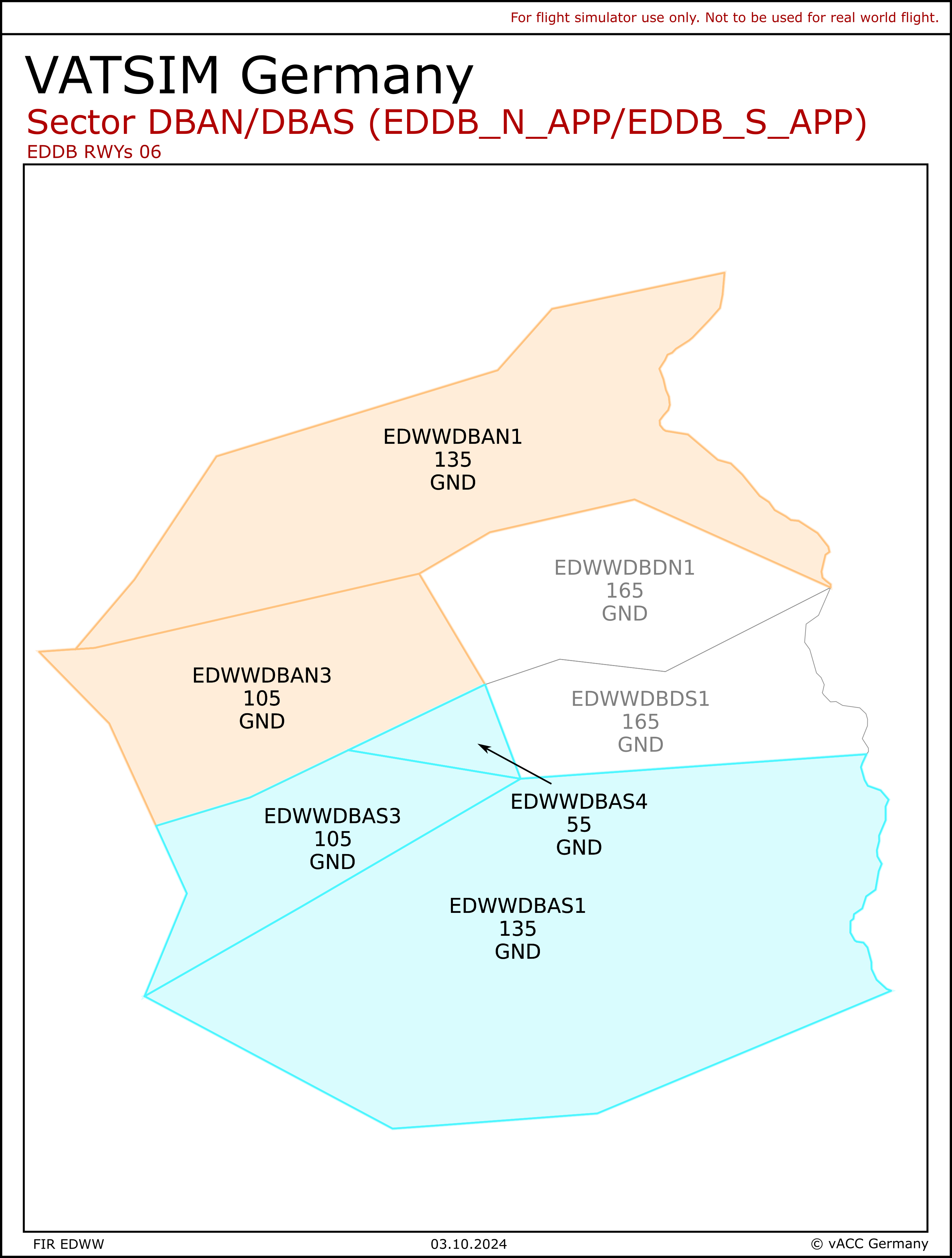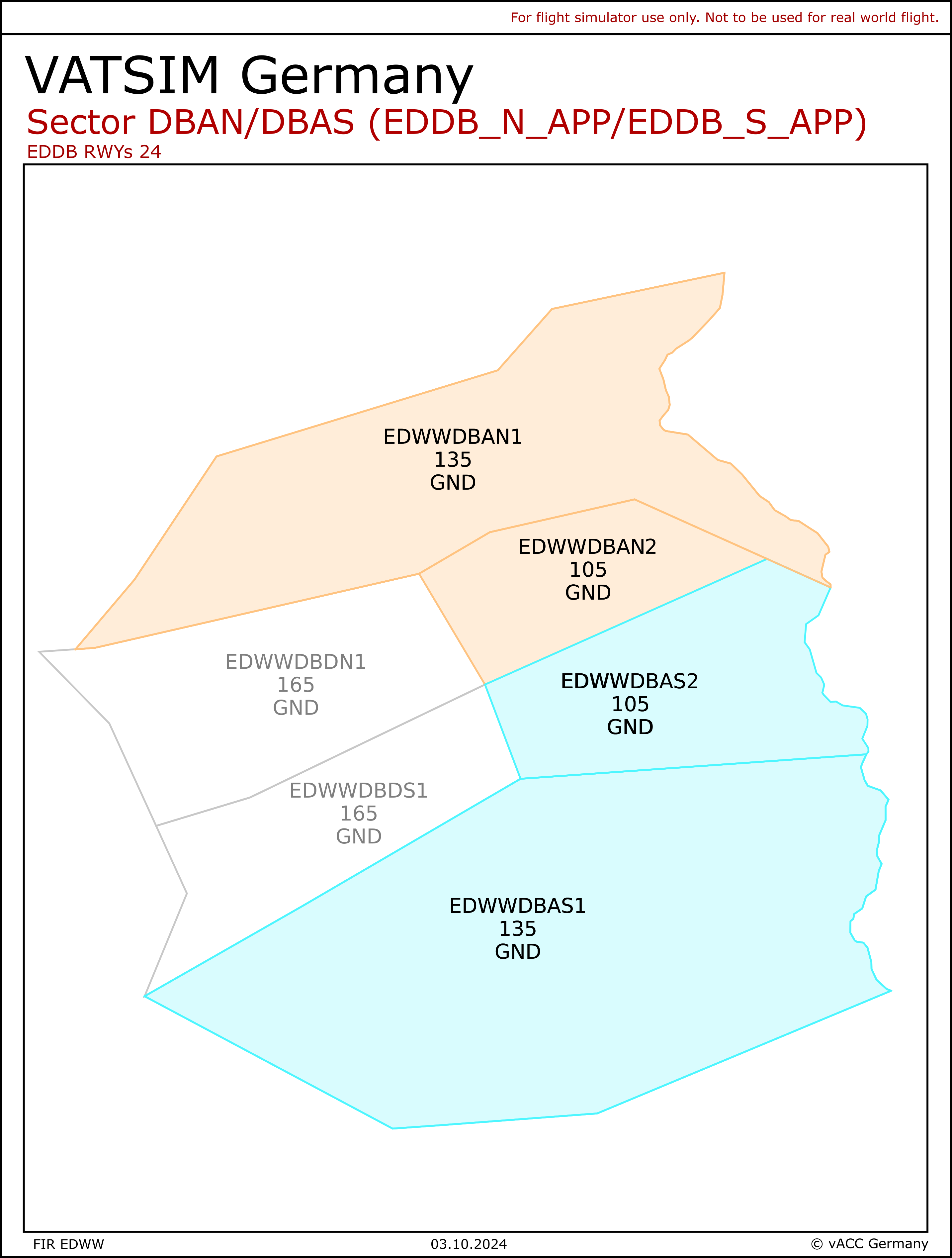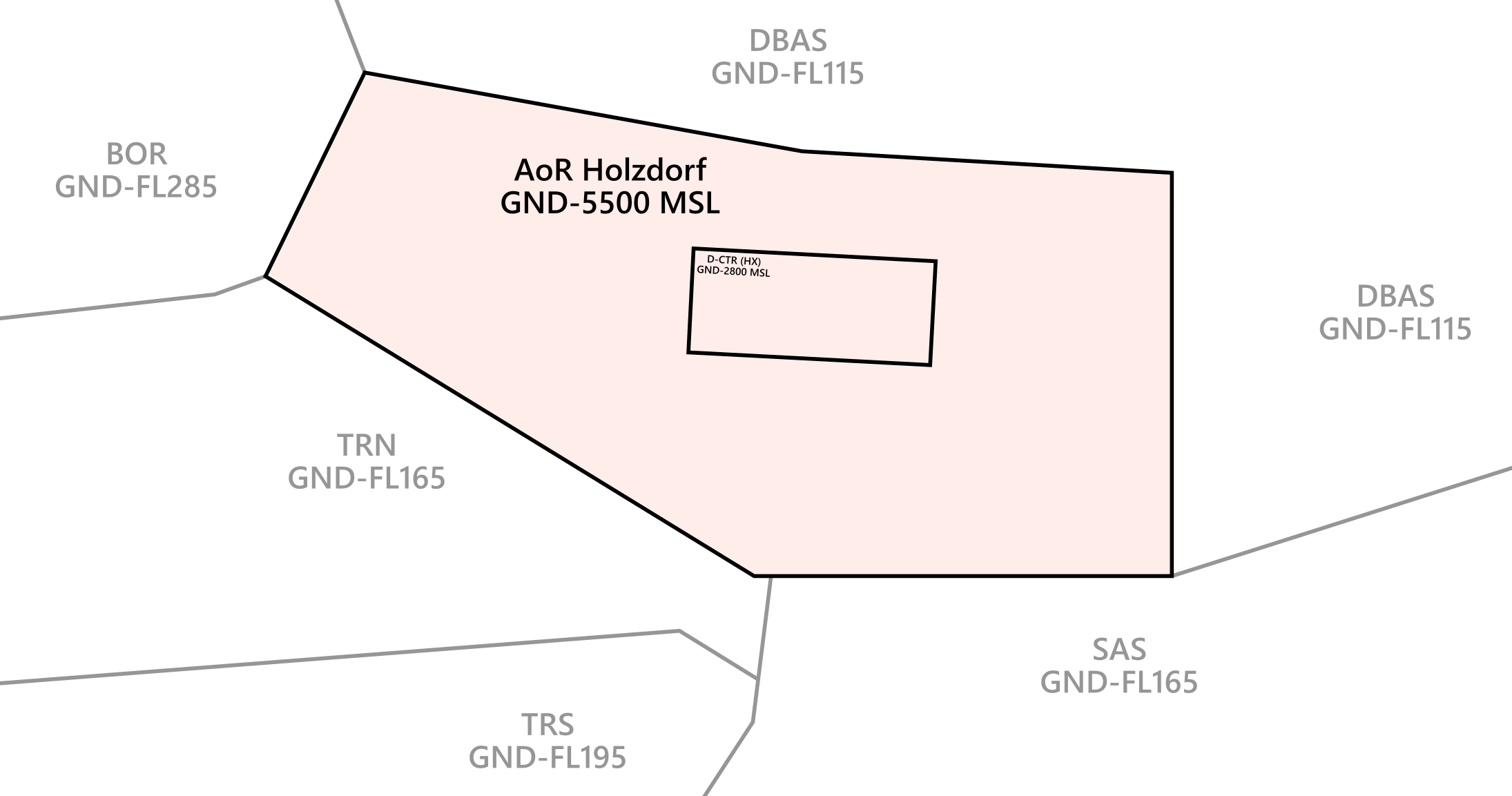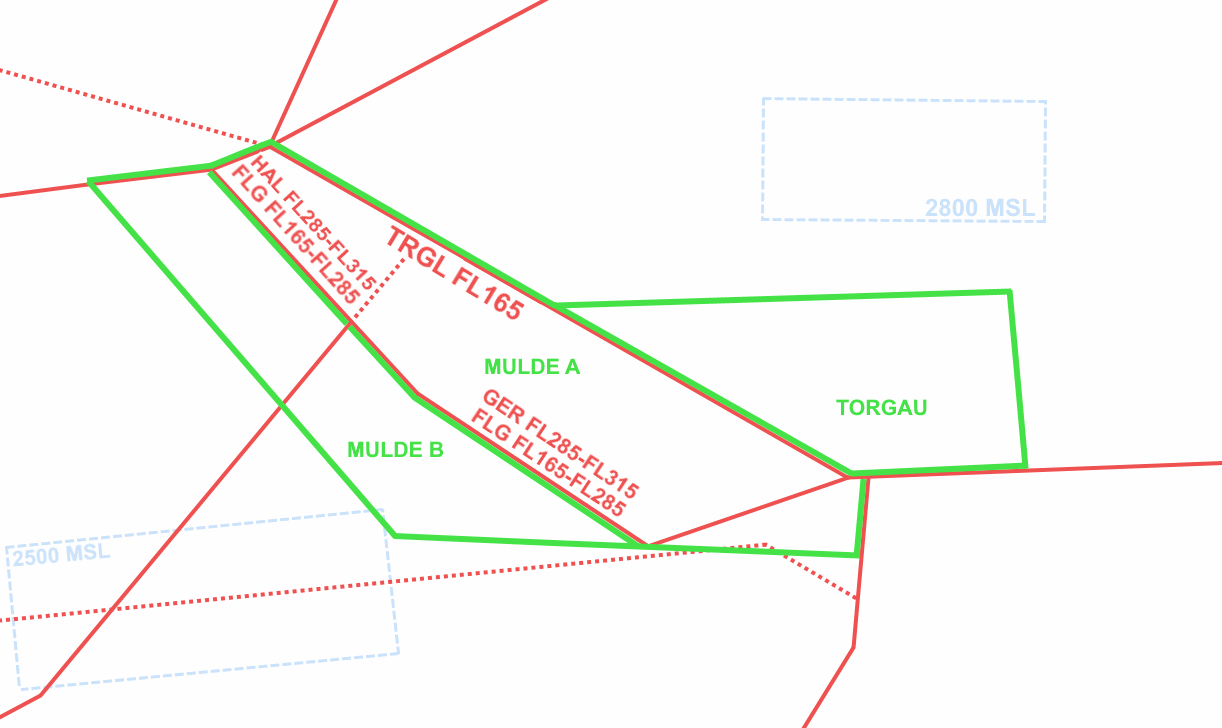Arrival
Sectorization and Airspace
Sector Berlin Arrival
| Station |
Station ID |
Frequency |
Login |
| Pickup |
|||
| Bremen Radar (Pickup Nord) |
DBAN | 119.630 |
EDDB_N_APP |
| Bremen Radar (Pickup Süd) | DBAS | 126.425 | EDDB_S_APP |
| Feeder |
|||
| Berlin Arrival (Feeder Nord) | DBANT | 136.105 | EDDB_AN_APP |
| Berlin Arrival (Feeder Süd) | DBAST | 121.130 | EDDB_AS_APP |
| Coordinator |
|||
| Berlin Coordinator | --- | --- |
Any middle locator which has higher priority than DBAN or DBAS |
Note: EDDB_N_APP may be staffed without the requirement of Departure to be online. In this case, EDDB_S_APP take over all responsibilities for DBDN and DBDS. To staff the DBAN-DBAS split, a Feeder must be online first.
All frequencies (incl. Berlin Departure) shall be cross-coupled by the responsible controller.
A second Feeder will only be staffed when Independent Parallel Approach operations are required.
The Coordinator position will take over all pre-planning responsibilities for the Pickup station. The main task is to coordinate all arrivals so that an initial sequence is created for the Pickup. The coordinator works on all coordination duties. Tags from the CTR station will always be transferred to the executive controller immediately. The Berlin Coordinator shall log in with a callsign having a higher priority than DBAN/DBAS (e.g. EDDB_C_APP) and the correct primary frequency selected.
Holzdorf AoR
Holzdorf AoR (ETSH_APP) may be staffed. This will delegate the airspace described below from GND to 5500 ft. Every movement between ETSH_APP and Bremen Radar requires prior coordination. Bremen Radar sector DBAS will perform top-down service when ETSH is offline (Bremen Radar will not provide SRA and PAR approaches).
TORGAU Area
EDMM sector TRN may request the activation of TORGAU Area during RWYs 26 at EDDP. See LoA EDWW-EDMM para 2.4.2.
Airspace
All active ED-Rs displayed on the radar screen shall be simulated. ED-R4 and ED-R146 will be active 24/7. Inbound traffic to EDDB shall always stay inside airspace class C. Level-offs might be necessary during descent to keep traffic inside protected airspace.
Arriving traffic to EDDB
Runway Allocation
The pilot shall be informed about the expected runway on initial contact with DBAN/DBAS.
In almost all circumstances, runways are assigned depending on the planned parking position to reduce taxi times:
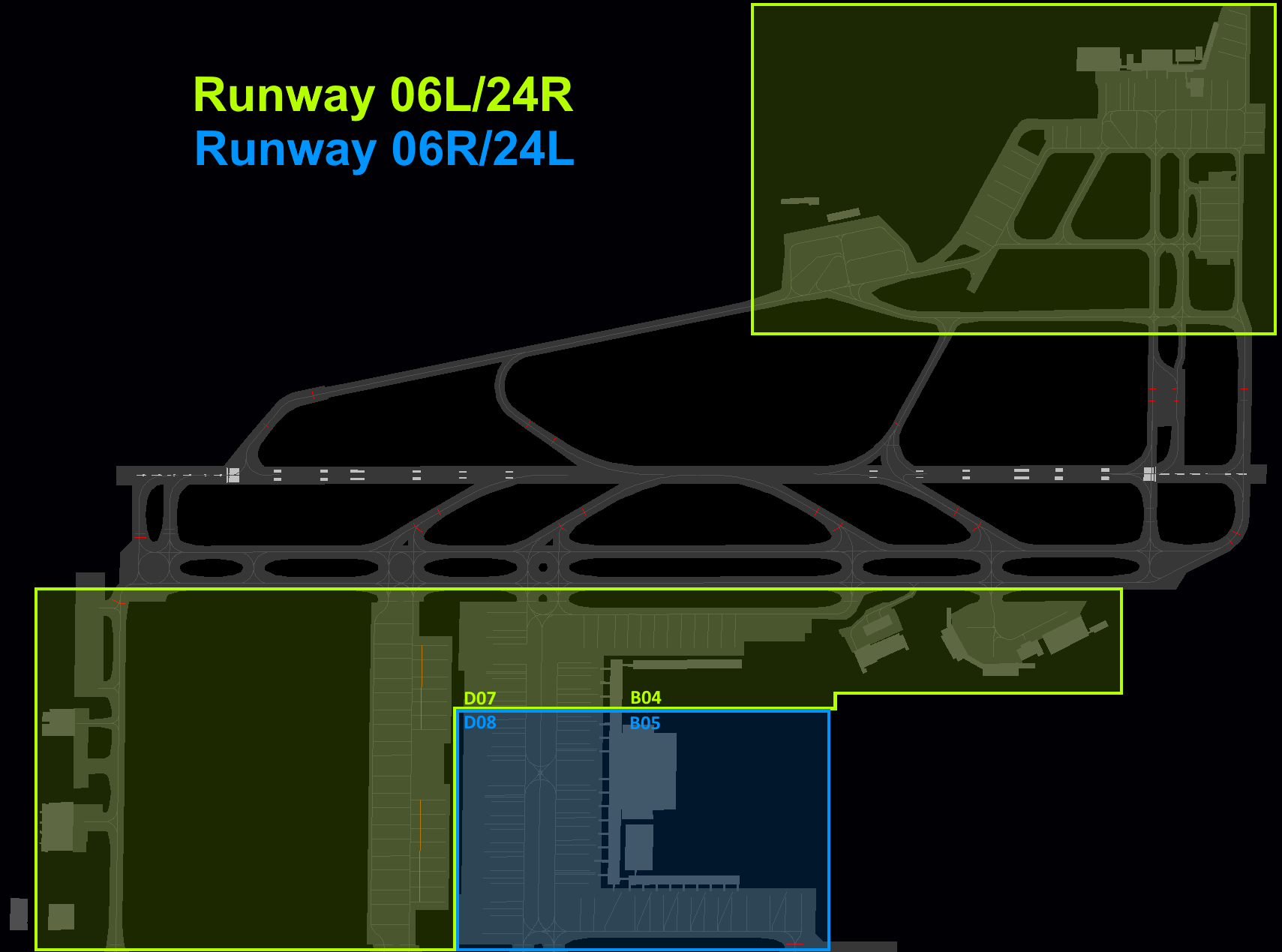
Depending on the traffic situation, DBAN/DBAS may deviate from this RWY distribution when required for load balancing.
Managing inbound traffic
In general, STARs will be cleared by APP only when necessary. Traffic will mostly be vectored to the final. Often, an initial direct to a waypoint on the STAR can guide the traffic efficiently. The full STARs are rarely used and are only designed as frequency relief procedures for Pickup.
Pickup shall make use of early coordination with ACC sectors MAR and FLG as well as with EPWW, in order to sequence traffic from the various clearance limits. Early coordinated headings, speeds and holdings will ensure a good traffic flow. Mostly, ACC sectors MAR and FLG explicitly wait for coordination with DBAN/DBAS before the transfer of communications is executed.
As traffic often is shortly prior to reaching the IAF/clearance limit (KETAP, OGBER, NUKRO, ATGUP, KLF), a further clearance on the initial call is recommended in order to avoid unwanted holdings.
Any approved/requested DCT for arrivals EDDB, given by DBAN/DBAS to MAR/FLG, shall include the approval to cross the airspace of sectors DBDN/DBDS!
Holdings
Published holdings are available at the IAFs/clearance limits. Holdings at KETAP and OGBER shall always be coordinated with ACC sector MAR. Holdings at NUKRO and ATGUP/KLF shall always be coordinated with ACC sector FLG.
- The Holdings at KLF and ATGUP are dependent. The traffic of both clearance limits will usually be managed inside one holding.
- Further information about holding procedures shall be found in the EDWW LoA para 4.1.4
Approach Types
There are 4 published approach types available at EDDB. By default, the ILS approach will be used.
| Runway |
Available Approach Types | Intercept Altitude |
| 06L/24R |
ILS Z, ILS Y, ILS X, LOC, RNP Z, RNP Y |
4000 ft |
| 06R/24L | 3000 ft |
When accepted by the pilots, Berlin Arrival may use short approaches out of 3000 ft via a 10 NM final on runway 06L/24R. For short approaches out of 2000 ft via a 6 NM final, prior coordination with Berlin Tower is necessary.
Segmented Approaches (ILS/RNP Y)
The segmented approaches (ILS/RNP Y) are noise-optimised approaches that will be used during times of low traffic. For these approaches, the extended centerline will be shifted to the north (06L) or to the south (06R, 24L) by 2400 m. Therefore, traffic will fly offset until reaching a 5 NM final, from where the extended centerline will be followed until touchdown.
Berlin Tower shall be informed about the use of ILS/RNP Y. Segmented approaches are not available for RWY 24R.
The ILS/RNP Y should only be cleared via the IAFs published for the approach.
ILS X
Bremen Radar shall inform Berlin Tower about the use of the ILS X. Due to the nature of the missed approach procedure, Bremen Radar shall apply a minimum separation of 15 NM behind every aircraft performing the ILS X approach. This separation shall also apply to aircraft on the parallel runway.
Modes of Operation
Berlin Airport is authorized for the following modes of operations:
| Mode |
Spacing between 06L/24R and 06R/24L |
| Staggered Approaches | 3 NM |
| Independent Parallel Approaches | --- |
| Dedicated Runway Operations (DROps) | --- |
Staggered approaches is the standard mode of operation. Independent parallel approaches will only be used when required due to traffic.
Behind every aircraft flying the ILS X, a minimum separation of 15 NM is required on both runways.
Independent Parallel Approaches
During periods of high traffic, independent parallel approaches may be used.
REQUIREMENTS AND PROCEDURES FOR INDEPENDENT PARALLEL APPROACHES
- Approved approach types at EDDB for independent approaches:
- ILS Z
- RNP Z but only with vertical guidance (LNAV only not authorized).
Procedures and requirements can be viewed here: https://knowledgebase.vatsim-germany.org/books/sops-fir-bremen/page/independent-approach-operations-ber
Independent parallel approaches may be performed with only one Feeder online. Performing this mode of operation without a Feeder it not allowed.
SUSPENSION OF INDEPENDENT PARALLEL OPERATIONS DUE TO METEOROLOGICAL CONDITIONS:
The meteorological conditions to be considered include, but are not limited to, the following:
- wind shear;
- turbulence;
- downdrafts; and
- crosswind and significant meteorological conditions such as thunderstorms, which might otherwise increase deviations from the final approach course or track to the extent that safety may be impaired.
Dedicated Runway Operations (DROps)
In Berlin, dedicated runway operations will be used during the following conditions:
- Low Visibility Procedures
- Suspension of Independent Parallel Departures (e.g. due to CB, wind shear, turbulence, downdrafts, strong crosswind)
- Special regulation of traffic flows (e.g. shuttle event)
For Berlin, the following runway configurations are preferred for dedicated runway operations:
- 06-Operations: 06L departures, 06R approaches
- 24-Operations: 24L departures, 24R approaches
Target Spacing
The following target spacings shall be used between aircraft on the same final, except if wake turbulence separation is higher:
| Conditions |
Target Spacing |
| Departures expected | 6 NM |
| No departures expected | 3 NM |
| Low Visibility Operations | 5 NM |
The approach shall assess the situation on the ground regarding departing traffic and shall adjust the target spacing accordingly. No coordination is required in order to reduce to 3 NM in case no departing traffic is expected between approaching aircraft.
Note: Berlin Tower may reduce aircraft on final inside the EDDB D(CTR) without any prior notification.
Handoff Pickup to Feeder
DBAN/DBAS shall guide arrivals to EDDB in such a way that an interim arrival sequence is reached prior to transferring the aircraft.
| TO | ALTITUDE | CONDITIONS |
| DBANT/DBAST | 5000 ft | Dependent Parallel Ops |
| DBANT | 6000 ft | Independent Parallel Ops |
| DBAST | 4000 ft | Independent Parallel Ops |
Noise Abatement
| Procedure |
Description |
|
FL70 between OGBER/KETAP |
Arrivals to EDDB shall not be cleared to descend below FL70 before passing a position abeam EDDB if guided north of the aerodrome but south of the direct line between OGBER and KETAP |
|
13 NM final runways 06L/R from 22:00 lcl - 06:00 lcl |
Vectored approaches to RWYs 06L/R shall be guided in a way that the aircraft is established on the final approach track 13 NM from the touchdown between 22:00 local time and 06:00 local time. Aircraft in an emergency or distress situation or an urgent exceptional situation (e.g. meteorological reasons) as well as visual approaches shall be exempted from this provision. |
|
Visual Approach RWYs 06/24 |
Whenever issuing a clearance for a visual approach the pilot shall be instructed to conduct the approach in such a way that the final approach is not less than 6 NM and descent below 2000 ft MSL will not be performed prior to reaching final approach. |
Strausberg (EDAY)
Strausberg (EDAY) is an uncontrolled aerodrome located about 20 NM northeast of EDDB. Due to published IFR procedures limited service has to be provided for IFR traffic:
- Approach clearance and approach monitoring
- IFR clearance
Responsible stations
| Conditions |
EDDB RWYs 06 | EDDB RWYs 24 |
| IFR clearance | DBDN | DBAN |
| Approach clearance | DBAN | DBAN |
| Approach monitoring | DBDN | DBAN |
Approach Types
There is one published approach type available at EDAY:
| Runway |
Available Approach Types | IAF | Altitude at IAF |
| 05/23 | RNP | RENKI | 4000 ft |
Coordination is required with the station responsible for the approach monitoring prior to the approach clearance from DBAN. Airacft will be transferred to this monitoring station when on the published procedure.
Schönhagen (EDAZ)
Schönhagen (EDAZ) is an uncontrolled aerodrome located about 15 NM southwest of EDDB. Due to published IFR procedures limited service has to be provided for IFR traffic:
- Approach clearance and approach monitoring
- IFR clearance
Responsible stations
| Conditions |
EDDB RWYs 06 | EDDB RWYs 24 |
| IFR clearance | DBAST | DBDS |
| Approach clearance | DBAS | DBAS |
| Approach monitoring | DBAST | DBDS |
Approach Types
There is one published approach type available at EDAY:
| Runway |
Available Approach Types | IAF | Altitude at IAF |
| 25 | RNP | MOSEX | 3000 ft or 4000 ft, depending on MVA |
| 07 | Only RNP 25 followed by circling runway 07 is available. | ||
Due to the crossing of EDDB D(CTR), Berlin Tower shall be informed about every approach on runway 25 at EDAZ.
Coordination is required with the station responsible for the approach monitoring prior to the approach clearance from DBAS. Airacft will be transferred to this monitoring station when on the published procedure.
The station responsible for the approach monitoring shall inform Berlin Tower about the IFR arrival at EDAZ once this traffic joins the approach procedure and once this traffic has landed.
Approaches EDDB runway 24L and IFR approaches EDAZ will be generally considered independent.

